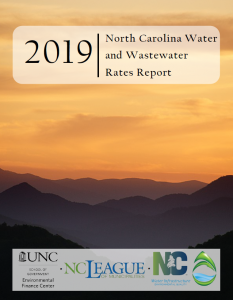Recently, the North Carolina Water and Wastewater Rates Dashboard was updated with 2019 data and the North Carolina Water and Wastewater Rates Report 2019 was published. Are you getting all you can out of these useful resources?
As the start of the new fiscal year approaches in July, utilities across North Carolina will be preparing to enact new water and wastewater rates in their communities. Rate increases can be perceived as negative to the general public, though they are necessary for financial sustainability, and ultimately to protect the public health of the communities they serve. How can utilities convey the important decisions that go into what many just see as an increase in their bill?
That’s where the resources from our 2019 North Carolina Water and Wastewater Rates Dashboard and Survey can help, providing easy to understand visuals, key takeaways from aggregated, statewide data, and the numbers behind it all.
Now in its twelfth consecutive year, you are probably familiar with the North Carolina Water and Wastewater Rates Dashboard—but are you using all of its features to your advantage? With the “Edit Data or Add Utility” feature users can input rates for the upcoming fiscal year and see how those changes affect the bill comparison, conservation pricing signal, and median community affordability in real time. Changing the numbers for community’s median household income or financial information will also update the median affordability and cost recovery dials.
For a broader look at the state, the North Carolina Water and Wastewater Rates Report 2019 summarizes this year’s trends and can answer many questions that might otherwise be vague guesses:
- What is the most commonly used type of rate structure?

- How does system size affect pricing?
- What is normal for residential irrigation rates?
- How does our consumption allowance compare to utilities in the rest of the state?
- Are our rates in line with the statewide median affordability?
Find all of these topics and more in the newly published 2019 report.
When it comes time to explain how and why your rates may be changing, let the EFC’s data-driven resources do some of the talking for you. The Water and Wastewater Rates Dashboard can give you quick, visual answers to complex questions and comparisons for your utility. Use the newly published North Carolina Water and Wastewater Rates Report to understand the larger context of rates in the state.
Last but not least, the downloadable spreadsheet tables contain rate structures and bill amounts for those who want to dive into the straight numbers. Whether these resources are new to you or familiar staples, there are tools and features that can help effectively communicate decisions about your utility’s position and goals for the upcoming year.
Have you used our Rate Dashboard, Rates Report, tables, or other tools to change your rates? Let us know.



